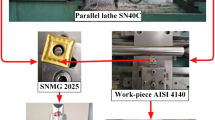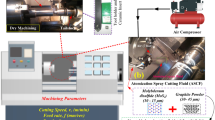Abstract
The objective of this study is to determine optimum machining parameters during high-speed turning (up to 1500 m/min) of Al 6061 T6 alloy. The chosen machining parameters optimize the trade-off between three competing responses: specific cutting energy, material removal rate, and surface roughness. These responses were first analyzed independently to establish their conflicting nature. Individual responses were then combined to formulate a multi-objective function using gray relational analysis augmented with analytic hierarchy process. Multi-objective function was optimized using regression analysis and response surface optimization. Analysis of variance results revealed cutting feed to be the most significant machining parameter affecting multi-objective function, followed by cutting speed and depth of cut. The proposed machining parameters resulted in reduction of specific cutting energy by 5% and an improvement of 33% in material removal rate while surface roughness remained unaffected.
Similar content being viewed by others
References
Dahmus JB, Gutowski TG (2004) An Environmental Anlysis of Machining, in ASME International Mechanical Engineering Congress and RD&D Expo, pp 1–10
Li W, Kara S (2011) An empirical model for predicting energy consumption of manufacturing processes: a case of turning process. Proc Inst Mech Eng B J Eng Manuf 225(9):1636–1646
Thiede S, Bogdanski G, Herrmann C (2012) A systematic method for increasing the energy and resource efficiency in manufacturing companies. Procedia CIRP 2(1):28–33
Moradnazhad M, Unver HO (2016) Energy consumption characteristics of turn-mill machining. Int J Adv Manuf Technol 91(5–8)
Gutowski T, Dahmus J, Thiriez A (2006) Electrical energy requirements for manufacturing processes, in 13th CIRP International Conference On Life Cycle Engineering, pp 623–628
Warsi SS, Jaffery SHI, Ahmad R, Khan M, Agha MH, Ali L (2018) Development and analysis of energy consumption map for high-speed machining of Al 6061-T6 alloy. Int J Adv Manuf Technol 96(1–4):91–102
Groover M (2010) Fundamentals of modern manufacturing: materials, processes, and systems, 4th edn. Wiley, Hoboken
Shaw MC (2005) Metal cutting principles, 2nd edn. Oxford University Press, Oxford
Warsi SS, Jaffery SHI, Ahmad R, Khan M, Ali L, Agha MH, Akram S (2017) Development of energy consumption map for orthogonal machining of Al 6061-T6 alloy. Proc Inst Mech Eng B J Eng Manuf. https://doi.org/10.1177/0954405417703424
Sarwar M, Persson M, Hellbergh H, Haider J (2009) Measurement of specific cutting energy for evaluating the efficiency of bandsawing different workpiece materials. Int J Mach Tools Manuf 49(12–13):958–965
Hanafi I, Khamlichi A, Cabrera FM, Almansa E, Jabbouri A (2012) Optimization of cutting conditions for sustainable machining of PEEK-CF30 using TiN tools. J Clean Prod 33:1–9
Bhushan RK (2013) Optimization of cutting parameters for minimizing power consumption and maximizing tool life during machining of Al alloy SiC particle composites. J Clean Prod 39:242–254
Camposeco-Negrete C (2015) Optimization of cutting parameters using response surface method for minimizing energy consumption and maximizing cutting quality in turning of AISI 6061 T6 aluminum. J Clean Prod 91:109–117
Kant G, Sangwan KKS (2014) Prediction and optimization of machining parameters for minimizing power consumption and surface roughness in machining. J Clean Prod 83:151–164
Yan J, Li L (2013) Multi-objective optimization of milling parameters—the trade-offs between energy, production rate and cutting quality. J Clean Prod 52:462–471
Kumar R, Bilga PS, Singh S (2017) Multi objective optimization using different methods of assigning weights to energy consumption responses, surface roughness and material removal rate during rough turning operation. J Clean Prod 164:45–57
Campatelli G, Lorenzini L, Scippa A (2014) Optimization of process parameters using a response surface method for minimizing power consumption in the milling of carbon steel. J Clean Prod 66:309–316
Kuram E, Ozcelik B, Bayramoglu M, Demirbas E, Simsek BT (2013) Optimization of cutting fluids and cutting parameters during end milling by using D-optimal design of experiments. J Clean Prod 42:159–166
Chabbi A, Athmane M, Meddour I, Nouioua M, Mabrouki T (2017) Predictive modeling and multi-response optimization of technological parameters in turning of polyoxymethylene polymer (POM C) using RSM and desirability function. Measurement 95:99–115
Bagaber SA, Yusoff AR (2018) Multi-responses optimization in dry turning of a stainless steel as a key factor in minimum energy. Int J Adv Manuf Technol 96:1109–1122
Herbert Schulz TM (1992) High-speed machining. CIRP Ann Manuf Technol 41(2):637–643
Kalpakjian S, Schmid SR (2013) Manufacturing engineering and technology. Pearson Education, Limited, London
Black JT, Kohser RA (2008) DeGarmo’s materials and processes in manufacturing, 10th edn. Wiley, Hoboken
Sandvik Coromant, Turning tools, 2015
ISO 3685: tool-life testing with single-point turning tools. International organization for standardization (ISO): Geneva, Switzerland. 1993. (1993)
Jaffery S, Mativenga P (2009) Assessment of the machinability of Ti-6Al-4V alloy using the wear map approach. Int J Adv Manuf Technol 40:687–696
Warsi SS, Jaffery HI, Ahmad R, Khan M, Akram S (2015) Analysis of power and specific cutting energy consumption in orthogonal machining of Al 6061-T6 alloys at transitional cutting speeds. Adv Manuf 2B:V02BT02A057
Ross PJ (1996) Taguchi techniques for quality engineering. McGraw-Hill, New York
Balogun VA, Mativenga PT (2014) Impact of un-deformed chip thickness on specific energy in mechanical machining processes. J Clean Prod 69:260–268
Camposeco-Negrete C (2013) Optimization of cutting parameters for minimizing energy consumption in turning of AISI 6061 T6 using Taguchi methodology and ANOVA. J Clean Prod 53:195–203
Deng J (1989) Introduction to grey system theory. J Grey Syst 1:1–24
Tzeng C, Lin Y, Yang Y, Jeng M (2009) Optimization of turning operations with multiple performance characteristics using the Taguchi method and grey relational analysis. J Mater Process Technol 209(6):2753–2759
Saaty TL (2008) Decision making with the analytic hierarchy process. Int J Serv Sci 1(1):83–98
Saaty TL, Vargas LG (2012) Models, methods, concepts & applications of the analytic hierarchy process, vol. 175. Springer Science & Business Media.
Thepsonthi T, Özel T (2012) Multi-objective process optimization for micro-end milling of Ti-6Al-4V titanium alloy. Int J Adv Manuf Technol 63(9–12):903–914
Balogun VA, Edem IF, Adekunle AA, Mativenga PT (2016) Specific energy based evaluation of machining efficiency. J Clean Prod 116:187–197
Bhattacharya A, Das S, Majumder P, Batish A (2008) Estimating the effect of cutting parameters on surface finish and power consumption during high speed machining of AISI 1045 steel using Taguchi design and ANOVA. Prod Eng 3(1):31–40
Kant G, Sangwan KS (2015) Predictive modeling for power consumption in machining using artificial intelligence techniques. Procedia CIRP 26:403–407
Author information
Authors and Affiliations
Corresponding author
Rights and permissions
About this article
Cite this article
Warsi, S.S., Agha, M.H., Ahmad, R. et al. Sustainable turning using multi-objective optimization: a study of Al 6061 T6 at high cutting speeds. Int J Adv Manuf Technol 100, 843–855 (2019). https://doi.org/10.1007/s00170-018-2759-2
Received:
Accepted:
Published:
Issue Date:
DOI: https://doi.org/10.1007/s00170-018-2759-2




